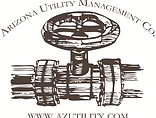

Email: customerservice@azutility.com
Office: (928) 925-4837
Hours: M - F: 8:00 a.m. - 2:00 p.m.
Could You Have A Leak?
Please see below for possible leaks and ways to identify them.

Toilet leaks can waste up to 200 gallons a day and can double a family's water use and bill. Make sure to do yearly inspections on toilets to verify the most common types of leaks: a deteriorated or improperly installed flush valve (flapper) located at the base of the toilet tank is creating a tight seal.
IS IT A TOILET LEAK?
The two main types of leaks in toilets are:
1. Flush Valve Seat Improperly Sealing:
How to check:
A. Take the lid off the tank and wait for it to fill completely.
B. Put a color dye tablet or food coloring drops into tank water.
C. Wait a minimum of 20 minutes or more and do not flush toilet.
D. If you see any color within the toilet bowl you have a leak.
2. Broken Fill Valve (attached to Float or combined with Float).
How to Check:
A. Remove the lid from the toilet Tank.
B. Flush Toilet
C. If you see water is still draining after tank refills then you should replace your fill valve assembly.
Leaky Faucet Or Irrigation System?
1. Leaking Faucet
How to Check:
A. Place an empty cup underneath the faucet
B. Check the cup every few hours.
(Make sure to check below any cabinets if its an indoor faucet. For exterior faucets make sure to check ground around faucet to verify its not an underground leak.)
2. Irrigation System Large Consumption?
How to Check:
A. Automated irrigation systems should be checked Regularly to verify they are functioning properly.
B. Verify your irrigation system has no broken sprinkler heads.
C. Look at sprinkler valve and verify that sprinkler valve is not stuck on, this could waste an extremely large quantity of water.
D. Verify irrigation system timer is programmed correctly and not overwatering.

Locating If Leak is within Home or Water Line.
Steps To Check for Water Leaks:
Disclaimer:
Please note that insects or animals may inhabit the water meter box. Exercise caution when opening the lid. Additionally, do not attempt to touch or tamper with the water meter itself, as this constitutes tampering with a public utility and may result in fines.
Pre-requisites:
A. Verify that all water fixtures, including faucets, toilets, showers, and appliances, are turned off within the house.
B. Carefully open the lid of the water meter box, being cautious of the potential presence of insects or animals such as spiders and snakes known to take shelter within the water meter box.
Checking for Leaks:
C. Check the water meter:
-
If the meter dial is spinning or the numbers on an electronic meter are increasing, it indicates a potential leak.
Determining If It's Within The House:
A. Turn off the water at the house shut-off valve, typically located near where the main water line enters the house or garage.
B. Check the water meter again:
-
If the meter dial is still spinning or the reading is increasing, it suggests a leak between your house and the water meter.
Additional Considerations:
-
Perform a visual inspection of common areas for leaks, including under sinks, around toilets, and near water-using appliances.
-
If a leak is detected, take immediate action to repair it or contact a plumber for assistance.